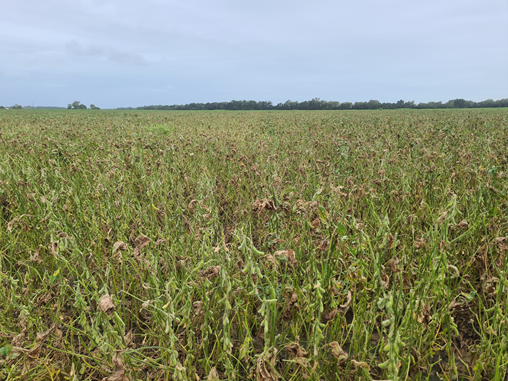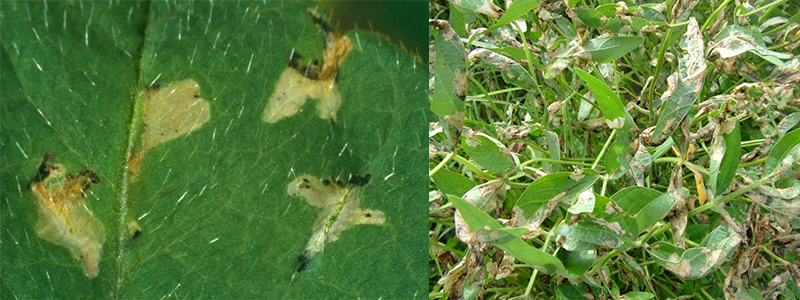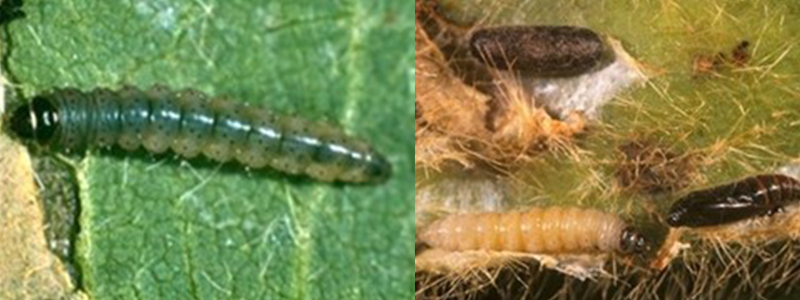Soybean moths are on the move in the tropics with devastating populations reported in the Ingham region of NQ (see photo). Fuelling the outbreaks was a recent extreme heatwave event which saw temperatures ranging between 29-40 degrees Celsius for 12 straight days.

Soybean moth damage can be devastating. Photo by Brock Dembowski
While the heat may have made people lethargic, it greatly hastened the rate of larval development and many crops progressed from no obvious signs of early damage to severe defoliation in five days. In extreme cases, some crops may be written off, particularly those which were unable to be irrigated. In an attempt to escape the heat, cluster caterpillars, legume web spinners and loopers were observed cohabitating in the webbed leaves built by the soybean moths, which only exacerbated the damage.
Monitoring is the key

Soybean moth adult (6 mm long)
The best way to avoid such disasters is to closely check crops for the early signs of heavy infestations and damage. Infestations are sometimes revealed by swarms of the small but distinctive dark moths with a narrow white transverse band, particularly in the crop when plants are disturbed, or sometimes around lights at night. High numbers of adults were first detected during beat sheet sampling in some crops around 14 days before severe damage, suggesting egg lays occurred well after initial detection.
An early sign of severe damage is numerous small leaf mines on every leaf (image 3). As larvae grow, these leaf mines increase in size and in severe infestations, will merge with other mines on the same leaf. In extreme cases, the mines may engulf entire leaves, giving nearly 100% defoliation. When monitoring for damage, pay careful attention to moisture stressed areas of the crop, such as along ridge tops or adjacent to tree lines.

Leaf mines, and leaf damage caused by soybean moth
When to take action?
Thresholds for soybean moth are based on percentage defoliation: 33% in the vegetative stage and 15-20% during pod-fill. Control is achieved with products containing 18 or 36 g/L abamectin at 300 or 150 mL active/ha under permit PER86185 (expires 30 April 2023). Abamectin has translaminar activity, enabling it to reach larvae feeding inside the leaves. Contact insecticides are ineffective against leaf-mining pests.
Before spraying, ensure larvae are still actively feeding (they are a translucent green/grey colour). White larvae are pre-pupal stage and have stopped feeding, and therefore will not be impacted by the insecticide. Note that abamectin has a 28 day withholding period.

Soybean moth larva (5 mm), pre-pupal larva, and pupae.
Varietal influences
Are all soybean varieties equally susceptible to soybean moth attack? In short we don’t know. However, in this recent outbreak, markedly more soybean moth caterpillar damage was observed in the cultivar Kuranda than in adjacent Mossman crops. This may be due the different leaf characteristics of these cultivars; with the latter having more waxy leaves. Obviously, the possibility of non-preference resistance is worth pursuing, and we would welcome any other observations of differences in damage levels between varieties.
Please contact Hugh Brier 0428 188 069, or Brock Dembowski on 0467 819 592 if you have a significant outbreak.
Article by Brock Dembowski and Hugh Brier.
Photos by Hugh Brier and Joe Wessels unless otherwise indicated.
